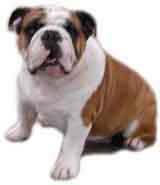Big DogsInformation About The Bulldog Dog Breed |
|
|
History and origin : Bulldogs were first used in England during the Middle Ages as baiters and fighters of bulls. They were originally bred to have courage and tenacity similar to the Mastiff. These early dogs were incredibly aggressive. It was not until the 19 th century that the present personable temperament was achieved. Description : The Bulldog stands 13 to 15 inches at the shoulder and weighs between 40 and 60 pounds. He has a dense, powerful body, an extremely blunt muzzle, a pronounced under-bite, and a short, smooth shedding coat that requires regular brushing with a fairly stiff brush. The color may be brindle, white, fawn, red, or patched. About the breed : The Bulldog is a courageous, intelligent, sweet, stubborn, incredibly strong dog that is filled with athletic enthusiasm. Despite his ferocious appearance, this breed has a docile temperament. He is extremely personable and loving, but because of his strength and enthusiasm, he is not always the best choice for the elderly or the disabled. Though normally not aggressive, he may resist training because he has a stubborn streak left over from his bull-fighting days. The Bulldog needs training from early on, particularly in learning not to pull on the leash, not to jump up on people, and in general to contain his exuberance. He is a fast-learner and loves taking part in games. He loves children and gets along well with strangers; just make sure he does not get overenthusiastic and knock your friends or your children with his bowling-ball body. Training should start form puppy hood and should be firm and persistent. You must gain adequate control of this eager, powerful, stubborn breed early in life. The Bulldog is susceptible to respiratory problems. He will snort and sneeze, spewing out undesirable secretions, usually while licking your face. The Bulldog also snores. In addition, the deep wrinkles on his face and forehead tend to get infected if not cleaned and powdered with cornstarch once a day. Some Bulldogs may need eyelid surgery if a condition known as entropion sets in, causing the eyelids to turn in so that the eyelashes rub against the cornea. This breed is also sensitive to extremes in temperature and can easily become overheated. Finally, because of his heavy frame, the Bulldog can develop structural problems and arthritis later in life. Do not take this dog jogging or let him get overweight.Feeding : Recommended feeding for this breed is 1 can (13.3oz) of high quality meaty product with biscuit added. 1 teaspoon of cod liver oil daily is recommended in winter. Ideal home : An apartment is fine provided this breed is exercised regularly. The owner of a Bulldog should be an active, capable leader who desires a sweet, personable, vigorous dog that is good with family and friends. Children are fine as long as no roughhousing is allowed. The elderly and the disabled may have difficulty dealing with this breed's high level of enthusiasm; the Bulldog can be a very physical animal and, in his eagerness to play, may knock his owner down and cause an injury. Time to train, exercise, and socialize this breed is important.Back to the Big Dog Breed article page
| |
|
Related News About Dogs ' ); // get rid of newsfeed display by carp CarpConf('poweredby',''); CarpCacheShow('http://classifieds.agriscape.com/syndicate/dogs.rss'); ?>
|
|
|
|
|
|
Copyright © 2006-2007 dogguidance.com |


